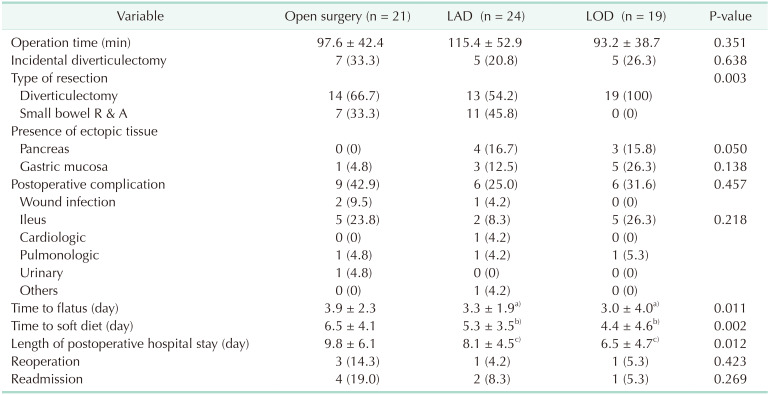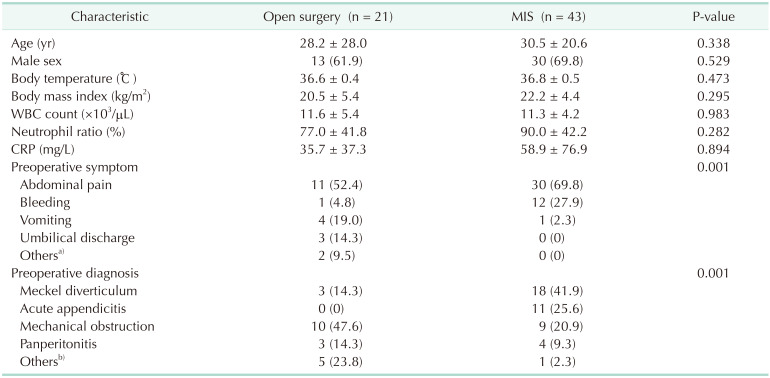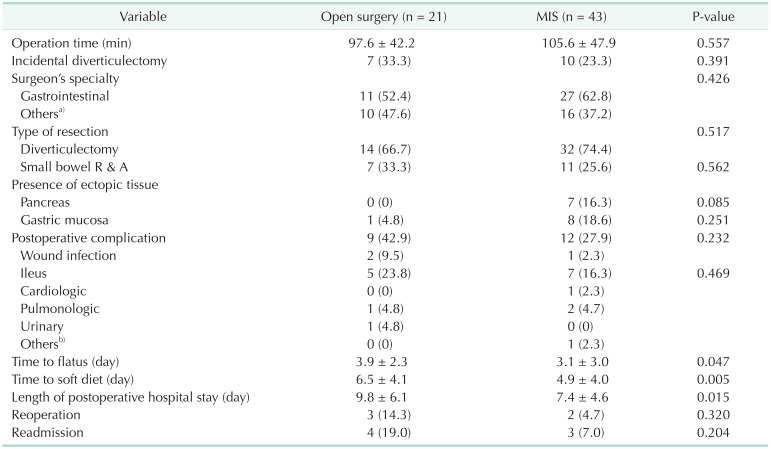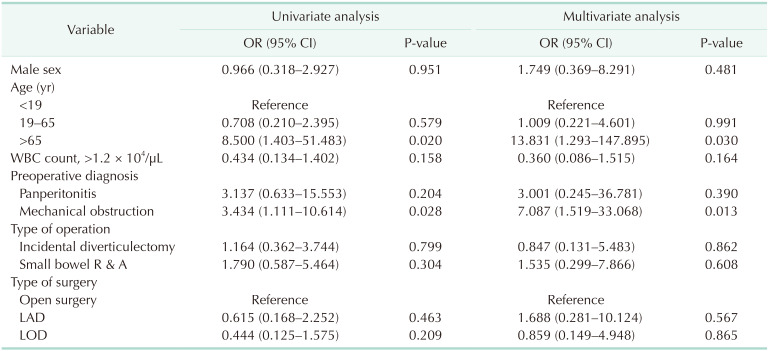1. Yahchouchy EK, Marano AF, Etienne JC, Fingerhut AL. Meckel's diverticulum. J Am Coll Surg. 2001; 192:658–662. PMID:
11333103.
2. Sharma RK, Jain VK. Emergency surgery for Meckel's diverticulum. World J Emerg Surg. 2008; 3:27. PMID:
18700974.
3. Kadian YS, Verma A, Rattan KN, Kajal P. Vitellointestinal duct anomalies in infancy. J Neonatal Surg. 2016; 5:30. PMID:
27433448.
4. Sohn HJ, Park KW, Lee NM, Kim MK, Lee SE. Meckel diverticulum in exomphalos minor. Ann Surg Treat Res. 2016; 91:90–92. PMID:
27478815.
5. Tam YH, Chan KW, Wong YS, Houben CH, Pang KK, Tsui SY, et al. Single-incision laparoscopic surgery in diagnosis and treatment for gastrointestinal bleeding of obscure origin in children. Surg Laparosc Endosc Percutan Tech. 2013; 23:e106–e108. PMID:
23752016.
6. Kawasaki Y, Shinozaki S, Yano T, Oshiro K, Morimoto M, Kawarai Lefor A, et al. Intussusception due to an inverted Meckel's diverticulum diagnosed by double-balloon enteroscopy. Case Rep Gastroenterol. 2017; 11:632–636. PMID:
29282383.
7. Mouawad NJ, Hammond S, Kaoutzanis C. Perforation of Meckel's diverticulum by an intact fish bone. BMJ Case Rep. 2013; 2013:bcr2012008226.
8. Tauro LF, Martis JJ, Menezes LT, Shenoy HD. Clinical profile and surgical outcome of Meckel's diverticulum. J Indian Med Assoc. 2011; 109:489–490. PMID:
22315842.
9. Ruscher KA, Fisher JN, Hughes CD, Neff S, Lerer TJ, Hight DW, et al. National trends in the surgical management of Meckel's diverticulum. J Pediatr Surg. 2011; 46:893–896. PMID:
21616248.
10. Papparella A, Nino F, Noviello C, Marte A, Parmeggiani P, Martino A, et al. Laparoscopic approach to Meckel's diverticulum. World J Gastroenterol. 2014; 20:8173–8178. PMID:
25009390.
11. Ding Y, Zhou Y, Ji Z, Zhang J, Wang Q. Laparoscopic management of perforated Meckel's diverticulum in adults. Int J Med Sci. 2012; 9:243–247. PMID:
22577339.
12. Palanivelu C, Rangarajan M, Senthilkumar R, Madankumar MV, Kavalakat AJ. Laparoscopic management of symptomatic Meckel's diverticula: a simple tangential stapler excision. JSLS. 2008; 12:66–70. PMID:
18402742.
13. Shalaby RY, Soliman SM, Fawy M, Samaha A. Laparoscopic management of Meckel's diverticulum in children. J Pediatr Surg. 2005; 40:562–567. PMID:
15793736.
14. Sai Prasad TR, Chui CH, Singaporewalla FR, Ong CP, Low Y, Yap TL, et al. Meckel's diverticular complications in children: is laparoscopy the order of the day? Pediatr Surg Int. 2007; 23:141–147. PMID:
17171378.
15. Chan KW, Lee KH, Mou JW, Cheung ST, Tam YH. Laparoscopic management of complicated Meckel's diverticulum in children: a 10-year review. Surg Endosc. 2008; 22:1509–1512. PMID:
18322735.
16. Yıldız A, Bertozzi M, Oral A, Melıh A, Ahıskalıoğlu A, Dokucu AI. Laparoscopic assisted approach to paediatric Meckel's diverticulum in laparoscopic era. SM J Pediatr Surg. 2017; 3:1053.
17. Duan X, Ye G, Bian H, Yang J, Zheng K, Liang C, et al. Laparoscopic vs. laparoscopically assisted management of Meckel's diverticulum in children. Int J Clin Exp Med. 2015; 8:94–100. PMID:
25784978.
18. Sarli L, Costi R. Laparoscopic resection of Meckel's diverticulum: report of two cases. Surg Today. 2001; 31:823–825. PMID:
11686565.
19. Schier F, Hoffmann K, Waldschmidt J. Laparoscopic removal of Meckel's diverticula in children. Eur J Pediatr Surg. 1996; 6:38–39. PMID:
8721178.
20. Teitelbaum DH, Polley TZ Jr, Obeid F. Laparoscopic diagnosis and excision of Meckel's diverticulum. J Pediatr Surg. 1994; 29:495–497. PMID:
8014801.
21. Levy AD, Hobbs CM. From the archives of the AFIP. Meckel diverticulum: radiologic features with pathologic Correlation. Radiographics. 2004; 24:565–587. PMID:
15026601.
22. Kotha VK, Khandelwal A, Saboo SS, Shanbhogue AK, Virmani V, Marginean EC, et al. Radiologist's perspective for the Meckel's diverticulum and its complications. Br J Radiol. 2014; 87:20130743. PMID:
24611767.
23. Menezes M, Tareen F, Saeed A, Khan N, Puri P. Symptomatic Meckel's diverticulum in children: a 16-year review. Pediatr Surg Int. 2008; 24:575–577. PMID:
18322689.
24. Rerksuppaphol S, Hutson JM, Oliver MR. Ranitidine-enhanced 99mtechnetium pertechnetate imaging in children improves the sensitivity of identifying heterotopic gastric mucosa in Meckel's diverticulum. Pediatr Surg Int. 2004; 20:323–325. PMID:
15241619.
25. Rho JH, Kim JS, Kim SY, Kim SK, Choi YM, Kim SM, et al. Clinical features of symptomatic Meckel's diverticulum in children: comparison of scintigraphic and non-scintigraphic diagnosis. Pediatr Gastroenterol Hepatol Nutr. 2013; 16:41–48. PMID:
24010105.
26. Attwood SE, McGrath J, Hill AD, Stephens RB. Laparoscopic approach to Meckel's diverticulectomy. Br J Surg. 1992; 79:211. PMID:
1532525.
27. Ezekian B, Leraas HJ, Englum BR, Gilmore BF, Reed C, Fitzgerald TN, et al. Outcomes of laparoscopic resection of Meckel's diverticulum are equivalent to open laparotomy. J Pediatr Surg. 2019; 54:507–510. PMID:
29661575.
28. Echenique M, Dominguez AS, Echenique I, Rivera V. Laparoscopic diagnosis and treatment of Meckel's diverticulum complicated by gastrointestinal bleeding. J Laparoendosc Surg. 1993; 3:145–148. PMID:
8518467.
29. Park JJ, Wolff BG, Tollefson MK, Walsh EE, Larson DR. Meckel diverticulum: the Mayo Clinic experience with 1476 patients (1950–2002). Ann Surg. 2005; 241:529–533. PMID:
15729078.
30. Cullen JJ, Kelly KA, Moir CR, Hodge DO, Zinsmeister AR, Melton LJ 3rd. Surgical management of Meckel's diverticulum. An epidemiologic, population-based study. Ann Surg. 1994; 220:564–568. PMID:
7944666.





 PDF
PDF Citation
Citation Print
Print






 XML Download
XML Download